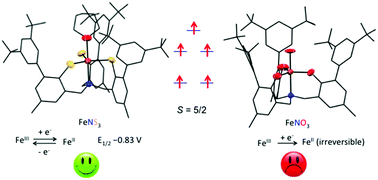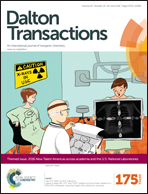Redox flexibility of iron complexes supported by sulfur-based tris(o-methylenethiophenolato)amine relative to its tripodal oxygen-based congener†
Abstract
Tripodal ligands designed to generate a local C3 symmetry have resulted in novel types of metal complexes that feature unusual bonding and electronic properties. However, most complexes reported to date are characterised by strong field ligands that enforce low or intermediate-spin states for the metal centres. Moreover, anionic sulfur-based tripodal ligands are particularly scarce due to their challenging synthesis. In this context, we herein report the synthesis, spectral characterization, structural, and electronic properties of an iron complex supported by the tripodal, trianionic ligand [N(CH2ArS)3]3− as the trigonal-bipyramidal complexes [Fe{N(CH2ArS)3}(X)] (1X, X = DMSO, THF). The solid-state structures reveal local C3v symmetry around the Fe3+ ions, while electron spin resonance measurements established a high-spin state (S = 5/2). Electrochemical studies demonstrate the redox flexibility of the FeS3 fragment by direct comparison with the oxygen-based analogue N(CH2ArOH)3, which displays an irreversible reduction; in contrast, 1THF has a reversible Fe3+/Fe2+ redox process at −0.83 V (relative to the ferrocenium/ferrocene redox couple). The high spin and redox properties of 1THF are attributable to the weak ligand field provided by the NS3 fragment, as confirmed by the electronic structure calculated by density functional theory, which reveals substantial electronic delocalisation and covalency of the Fe–S bonds in 1X.

- This article is part of the themed collection: New Talent: Americas

 Please wait while we load your content...
Please wait while we load your content...